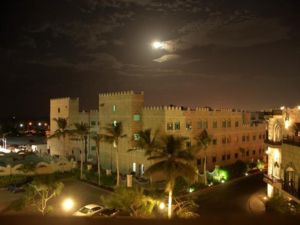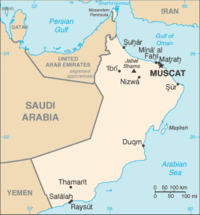
Oman History
Islam
had reached Oman within the prophet Muhammad's lifetime. By the
middle of the eighth century C.E., Omanis were practicing a unique
brand of the faith, Ibadhism, which remains a majority sect only
in Oman. Ibadhism has been characterized as "moderate conservatism," with tenets that are a mixture of both austerity and tolerance.
The Portuguese occupied Muscat
for a 140-year period (1508–1648), arriving a decade after
Vasco da Gama discovered the seaway to India. In need of an outpost
to protect their sea lanes, the Europeans built up and fortified
the city, where remnants of their colonial architectural style
still remain.
The Ottomans drove out the Portuguese,
but were pushed out themselves about a century later (1741) by
the leader of a Yemeni tribe, who began the current line of ruling
sultans. After one last, brief invasion a few years later by Persia,
Oman was free for good of foreign-occupying powers.
 Isolated
from their Arab neighbors by the desert, the Omanis became an
economic power in the early 1800s, largely by using their position
on the Indian Ocean and seafaring knowledge gained from the Portuguese
to gain access to foreign lands. They took control of the coasts
of present-day Iran and Pakistan, colonized Zanzibar and Kenyan
seaports, brought back enslaved Africans, and sent boats trading
as far as the Malay Peninsula. Isolated
from their Arab neighbors by the desert, the Omanis became an
economic power in the early 1800s, largely by using their position
on the Indian Ocean and seafaring knowledge gained from the Portuguese
to gain access to foreign lands. They took control of the coasts
of present-day Iran and Pakistan, colonized Zanzibar and Kenyan
seaports, brought back enslaved Africans, and sent boats trading
as far as the Malay Peninsula.
At this time, the country became known as Muscat
and Oman*, denoting two centers of power, not just the capital
and the interior but also the sultan and the imam, the Ibadhist
spiritual leader.
The British slowly brought about a collapse of
Muscat and Oman's "empire" by the end of the nineteenth
century without use of force. Through gradual encroachment on
its overseas holdings economically and politically, they caused
Oman to retreat to its homeland. In time Britain held such sway
in Muscat and Oman itself that it became in effect, and later
in fact, a British protectorate.
Having control of the country's military, the
British helped subdue rebel tribesmen in the 1950s, driving most
into Yemen. But the sultan ran a repressive regime, with laws
forbidding numerous activities, including the building and even
repair of his subjects' own homes without permission. In 1970,
almost certainly with British backing, he was overthrown by his
son, the present ruler, Qaboos bin Said Al Said, and the country
declared independence the following year as the Sultanate of Oman.
Qaboos is generally regarded as a benevolent absolute
ruler, who has improved the country economically and socially.
Oman has maintained peaceful ties on the Arabian Peninsula ever
since ending another tribal rebellion in the southwest in 1982
by forging a treaty with Yemen. Oman's oil revenue has been consistently
invested in the national infrastructure, particularly roads, schools,
hospitals, and utilities. More than ever, the country is poised
to take advantage of its strategic trade location on the Indian
Ocean and the Persian Gulf to further its economic growth and
role in the world.
Except
for those who travel to remote Middle East locales, the country
has seldom been in the public eye other than for the use of its
military bases by U.S. forces in recent years. American and British
bombing raids were launched in 1991 from Oman against Iraq in
the Gulf War. A decade later, U.S. forces stationed there were
involved in raids against Afghanistan and Osama bin Laden.
|
|